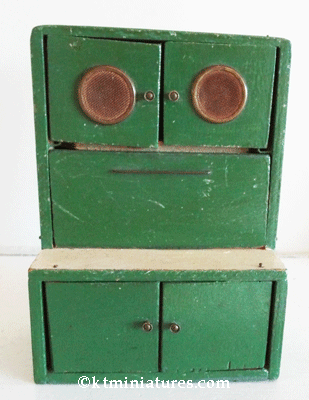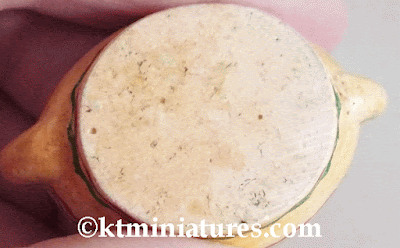In recent days two items were instantly snapped up as soon as they went up for sale on KT Miniatures website. Unsurprisingly really as they were both rare and very special pieces, plus remarkably they were both in fantastic condition! They are now in situ in their new separate homes, but I thought I would feature them on here as they are rarely seen.
c1930s Pit-a-Pat "Easywork Dresser"
How so very "1930s" this piece is, made by Pit-a-Pat and in original condition. It was described in a 1930s Pit-a-Pat advert as being an "Easywork Dresser", many of us used to call these kind of kitchen cabinets as being "Maid Savers". I grew up with a 1950s version in our draughty old Cotswold stone lodge house.
This is in its original green painted colour with white painted pull-down flap and worktop.
As you can see, there are two upper doors with round metal and mesh vents plus all the doors have original tiny metal handles. The pull down worktop has its original long metal handle.
The top two doors open to reveal five original mock cannisters. The "cannisters" are just one piece of green paper with black detail including black lettering, which is fixed to a long piece of wood that is stuck to the shelf. The lettering on the cannisters is as follows: TEA, COFFEE, RICE, RAISONS & SAGO.
The lucky new owner is going to have great fun filling this dresser.
Here is a rare Kaybot plaster tureen of soup, that comes in its original musty yellow painted colour, with green and red wavy lined decoration around the sides.
Also, around the rim there is an exquisite hand painted green wavy line and red dotted decoration. The naivety of the decoration adds to the charm. The soup itself is a kind of reddish colour, so am assuming this is possibly meant to be tomato soup?
It measures 1 3/4" long x 1 1/8" wide x just over 1/2" high. Underneath it appears that the usual Kaybot ink stamp has more or less been rubbed off over time. But overall, this little gem is in a wonderful played with condition, absolutely no cracks or damage which is amazing since this dates to the early 1950s.
Celia














No comments:
Post a Comment